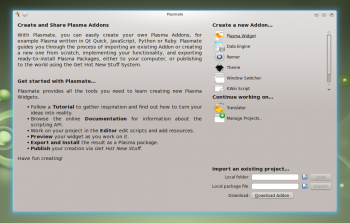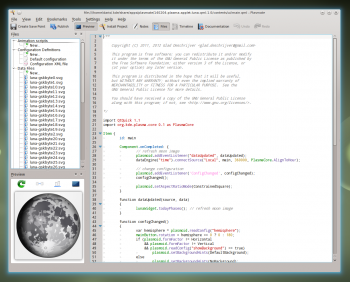Plasma/PlasMate: Difference between revisions
→First Impressions: +screenshot |
→The Work Interface: +screenshot |
||
| Line 30: | Line 30: | ||
=== The Work Interface === | === The Work Interface === | ||
[[File:Plasmate mainwindow.png|350px|thumb|left|Start page of plasmate]] | |||
The main work interface will be divided into two area: the editor/viewer as the | The main work interface will be divided into two area: the editor/viewer as the | ||
| Line 56: | Line 58: | ||
* widgets explorer (listing of Plasma::Widgets, links to the doc) | * widgets explorer (listing of Plasma::Widgets, links to the doc) | ||
=== Editor / Viewer === | === Editor / Viewer === | ||
Revision as of 22:39, 29 June 2012
PlasMate
A complete solution for developing Plasma “widgets”, themes, dataengines, ions and krunners. Lowering the bar for contribution to the KDE community.
First Impressions

On launch the window will contain only a "start page". Logo at the top, tagline describing what it does right under that (bonus points for an animation when it appears).
Beneath that three sets of options: Continue Working On.., Create a New..., Open An Existing...
Each of those options will then have a list of clickable links to get started.
Continue Working On will list the last few projects opened, or be hidden if there are no recent projects.
Create A New will include options for Widgets, DataEngine or Theme.
Open An Existing will provide those as well, but launch a file dialog.
The intended user experience is "launch, click, work!" No menu bars, no project workspace by default (like a normal IDE tends to) on first launch.
Once started, the work flow is: edit, preview, repeat, save point, repeat, publish ... repeat. ;)
The Work Interface

The main work interface will be divided into two area: the editor/viewer as the main widget, and toolboxes to provide workflow.
The most important toolbox will be the Package Listing. This will be a tree that shows the contents of a Plasma::PackageStructure. Given that we know from the PackageStructure the mimetypes, etc, of each entry we can use this to make it easy to add items.
Each directory in the listing will have an "Add.." entry, and the metadata.desktop file will also be listed. Behind the scenes, it will use a KDirWatch to update based on the filesystem.
Other toolboxes will include:
- the Widget previewer: with buttons to set the form factor and location as well
as reload the widget. This way the author can simply preview their widget as they go, including interction.
- timeline: save point browser and selector
- notes/todos: a place for the author to collect their thoughts as they work (<-- very very nice idea)
- documentation
- widgets explorer (listing of Plasma::Widgets, links to the doc)
Editor / Viewer
When an entry is selected in the Package Listing, the selected file will be shown in the Editor/Viewer. Using KParts for all but a few types of entries will allow the user to edit code, view SVGs (we probably don't want the user to view/edit svgs with a kpart. dunno if you remember the application i made some time ago to help testing themes, but I think that i can integrate that with some information taken from plasma, like elements that can be themed... this requires some thinking...), etc. without having to write any appreciable amount of code ourselves.
There are some editors that will need to be written from scratch, however. These include:
- Metadata: a simple form that lets one fill in the metadata. Plasmagik should
have some code about this.
- KConfigXt: a form to create KConfigXt files; this will be used for both the
configuration entries in a widget as well as Service .operation files.
- SVG theme visualizer (look at ruphy's app)
Integrating Qt Designer would also be a goal at some point. Tricky though, especially for the code it will generate. Requires further thinking, and not for the first releases.
Integrated Revision Control, or the Save-less Interface
Integrating a simple git-based revision control system will be critical to providing both a smooth user experience as well as making publishing and social interaction possible.
When creating a new widget, it will be automatically saved into the plasmate appdata dir and a local git repository started for it. The user will be able to create Save Points as they go. This will simply do a git commit of all the work done to this point, adding files that are new, etc. The user will be prompted for a summary of changes.
This will allow the user to then "roll back" to any given save point via the timeline toolbox.
We will then provide an online git hosting system on plasma.kde.org. (based on gitorious?) When the user hits "Publish" they will be prompted whether they would like to create a local package or publish it publicly. If the latter is chosen, a git push will be done and their work will appear on our shared git repo.
The hosting system will create Plasma::Packages out of the git repos for download; this is simply a matter of getting rid of any git metadata in the directry structure and creating a zip archive out of that, which is an easily automated task. Consumers will get Packages, creators can push and pull repos.
Neither consumer nor user should have to understand what's actually happening.
If the user does not already have an account on the shared git repo, they will be prompted to create one at this point. Some basic oversight will be needed: basically, just watching what new stuff goes up.
Eventually, we will want to have a widget browser integrated into Plasmate so that the user can see what is already available on plasma.kde.org and, with a click of a button, fork that widget and start working on it locally.
The required git functionality is therefore pretty basic on the Plasmate side:
- init a repo (milestone 1)
- add files (milestone 1)
- simple commits (milestone 1)
- change to a different commit, aka "roll back" (milestone 2)
- push (milestone 2)
- diffs (milestone 2)
- pull (milestone 3)
(what about enabling powerful users to get access to more advanced solutions? hmmm... obviously we should only do that if it doesn't clutter things for the target audience)
User Actions
Actions will be provided to the user in the work interface through a simple "see and click" interface that will be more like a toolbar or ribbon than a menu bar. These actions will include:
- Save Point
- Roll back (with history graph provided by the Timeline toolbox)
- Publish
- Exit / Leave
Code Design
Classes:
- StartPage
* Takes a pointer ot the main window * Creates the ProjectBox and other default toolboxes for a given action when selected
- ProjectBox
* ProjectView tree (maybe just a generic QTreeView?) * ProjectModel * based on Plasma::Package * uses a KDirModel internally to keep sync'd with disk * Takes a pointer to the main window to load viewers/editors with * Hosts the revision control object
- WidgetPreview
* Provides a Corona and View * Controls for: form factor, location, refresh. Translucent buttons at the top of the Previewer with those labels? Click on FF or L and a list of relevant choices will appear as an overlay?
- Actions
- Timeline
- SaveSystem
* Use the git classes from vng?
- Application
* Creates the main window * Creates the start page
Art / Design
Artwork and design work required:
- PlasMate logo: the Plasma logo with some elegant text
- The PlasMate tagline
- The layout of the main page. Qt Creator's take on this is very nice; should feel "webby"
Todo / Notes
Critical
- Allow file import, so that e.g. images can be added to a project
- Related: Treeview doesn't support drag and drop
- Metadata editor icon setter doesn't actually work.
- Proper templates/packaging for runners, dataengines and themes.
- Previewing for runners, themes and dataengines
Fit and finish items:
- Plasmoid previwer control buttons could use better icons, should have tooltips
- Metadata editor icon button is missaligned
- git directory should not be saved when exporting
- the export dialog is a bit full and confusing; perhaps turning it into a wizard might be better?
Desired
- Show author + version number in project list.
- Project description class to hold project related information
- What languages are supported
- What previewer to use
- If publishing is supported
- Per-project todo-style notes
- Project deletion from project management dialog which removes project from disk
- Project search/filter for project management dialog.
- Batch import/export
- Code auto completion for the script editor
Eventually
- Per-project window/dockwidget settings
- QtDesigner integration
- Separate process for previewer
Right now the plasmoid use-case is the most complete. What's possible:
- Creating projects and importing/exporting projects (to file)
- Editting code and metadata, auto-saving, previewing
- Creating / reverting to save points
- Browsing techbase tutorials and Plasma API references
- Publish to/Import from GHNS
